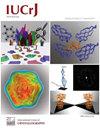Unravelling venetoclax solvate behaviour: insights from crystal structures and computational surface analysis
IF 3.6
2区 材料科学
Q2 CHEMISTRY, MULTIDISCIPLINARY
引用次数: 0
Abstract
Seven venetoclax solvates were structurally characterized and studied for their desolvation behaviour, leading to the identification of two solvent-free polymorphs. Advanced crystallographic and computational analyses, including Solvate Analyser, CSD-Particle, FTIR and solid-state NMR, revealed key factors governing solvate stability and transformation. Notably, the acetone solvate exhibited exceptional stability and the desolvated forms retained the molecular arrangement of their parent solvates.
This study investigates venetoclax solvates and their nonsolvated forms through desolvation. Seven solvates were prepared and their structures solved from single-crystal X-ray diffraction data. Among these, two are cavity solvates while the remaining five are channel solvates, with three being isomorphous. Desolvation experiments led to two solvent-free crystalline polymorphs of venetoclax, forms A and B. Notably, the acetone solvate remained stable and did not convert to a nonsolvated form. Form B has a higher melting point and a faster intrinsic dissolution rate than form A. Advanced computational tools, including Solvate Analyser and CSD-Particle, provided insights into crystal surface properties and desolvation behaviour. Properties such as lattice energy, molecular interaction energy, attachment energy, surface rugosity and solvent arrangement within the crystal and on the surface were linked to solvate stability and subsequent transformation upon desolvation. A combination of FTIR, and 13C and 15N solid-state NMR spectroscopies showed that both short- and long-range molecular interactions and arrangements of venetoclax molecules in the desolvated forms closely resembled those in the parent solvates.
解开venetoclax溶剂化行为:从晶体结构和计算表面分析的见解。
本研究通过脱溶剂法研究了venetoclax溶剂化物及其非溶剂化形式。制备了7种溶剂化物,并通过单晶x射线衍射数据对其结构进行了解析。其中两种为腔体溶剂化物,其余五种为通道溶剂化物,其中三种为同构溶剂化物。脱溶剂实验得到了两种无溶剂的venetoclax晶型,A型和b型。值得注意的是,丙酮溶剂化物保持稳定,没有转化为非溶剂化形式。与形式a相比,形式B具有更高的熔点和更快的固有溶解速率。先进的计算工具,包括Solvate Analyser和CSD-Particle,提供了对晶体表面性质和脱溶行为的深入了解。晶格能、分子相互作用能、附着能、表面粗糙度以及晶体内部和表面的溶剂排列等性质与溶剂化物的稳定性和脱溶后的后续转变有关。FTIR、13C和15N固体核磁共振谱分析表明,脱溶形式的venetoclax分子的短期和长期相互作用和排列与母体溶剂化物非常相似。
本文章由计算机程序翻译,如有差异,请以英文原文为准。
求助全文
约1分钟内获得全文
求助全文
来源期刊

IUCrJ
CHEMISTRY, MULTIDISCIPLINARYCRYSTALLOGRAPH-CRYSTALLOGRAPHY
CiteScore
7.50
自引率
5.10%
发文量
95
审稿时长
10 weeks
期刊介绍:
IUCrJ is a new fully open-access peer-reviewed journal from the International Union of Crystallography (IUCr).
The journal will publish high-profile articles on all aspects of the sciences and technologies supported by the IUCr via its commissions, including emerging fields where structural results underpin the science reported in the article. Our aim is to make IUCrJ the natural home for high-quality structural science results. Chemists, biologists, physicists and material scientists will be actively encouraged to report their structural studies in IUCrJ.
 求助内容:
求助内容: 应助结果提醒方式:
应助结果提醒方式:


